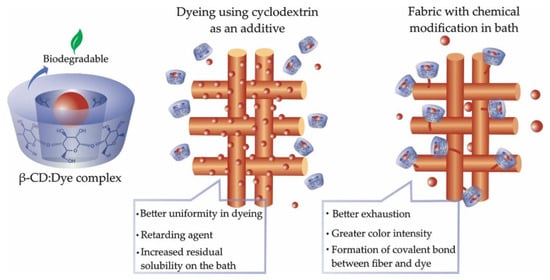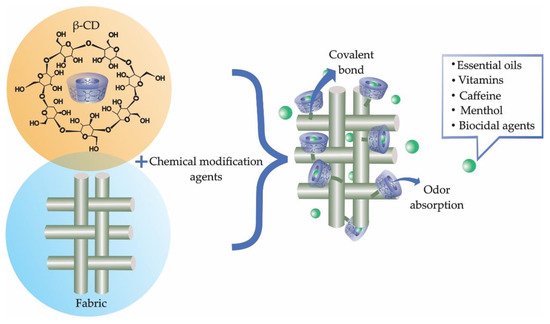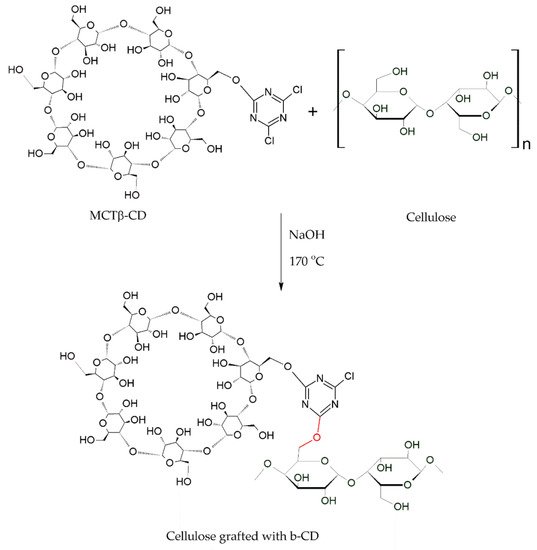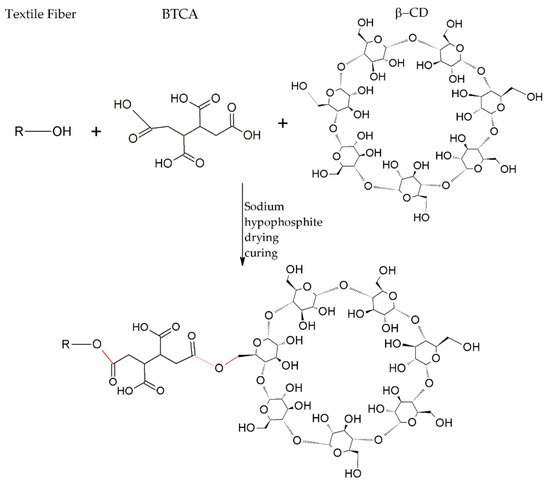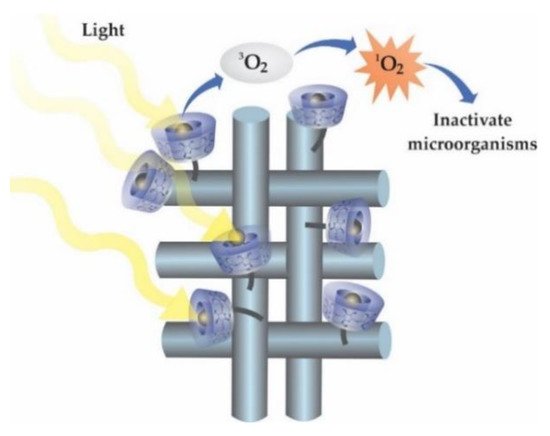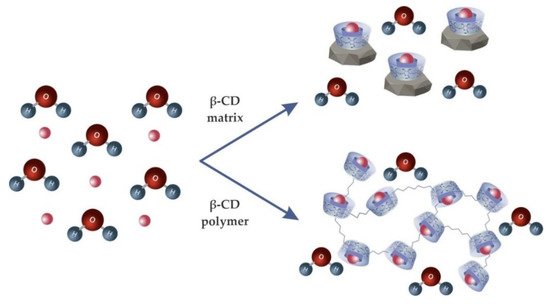1. Dyeing Process
The use of cyclodextrins in the dyeing process can include their use as a dyeing aid, forming a complex with the dye
[1][2][33,82], or as a chemical modification of the surface
[3][4][83,84].
Figure 13 shows these two processes.
Figure 13.
Use of cyclodextrins in dyeing.
CDs can form a variety of inclusion complexes with textile dyes, and this inclusion changes their properties, directly influencing the quality of the dyeing. Therefore, cyclodextrins can be used as auxiliaries in the dyeing process.
1.1. Cyclodextrin as an Auxiliary Agent in Dyeing
The introduction of new auxiliaries in the textile industry is feasible when they are used in low concentrations, are biodegradable, and do not affect the quality of the effluent. In addition to being biodegradable, CDs do not cause problems in textile effluents, and they improve the biodegradability of many toxic organic substances
[5][6][17,68]. Their use is due to their formation of complexes with dyes, and they can be used to improve the uniformity of dyes and washing processes
[2][7][8][31,82,86]. However, for the cyclodextrin to act as an auxiliary, the formation of the CD:dye complex is essential; if it is not formed, there will be no improvement in the quality of the dyeing
[9][10][75,95].
In the dyeing of polyester fibers, dyes of the dispersed type are used for the coloring of the substrate
[11][100]. These dyes are poorly soluble in water and generally require the use of surfactants
[12][73], which are products from non-renewable sources that cause environmental problems and must be replaced to reduce damage
[13][85]. Therefore, cyclodextrins are an alternative to these products that can maintain the quality of the coloring of the textile article
[6][68].
With regards to natural fibers, cotton is one of the most important textile fibers
[14][104] and, in its dyeing, the use of reactive and direct dyes stands out. Reactive dye has structure groups that covalently bond with the fiber, improving the solidity; however, they have low affinity, requiring high amounts of electrolytes for good dyeing to occur
[15][105]. Direct dye, on the other hand, has a high affinity for the cotton fiber
[16][106] and it is often necessary to use retarding agents, such as alkaline salts, to prevent stains on the fabric and thus achieve better leveling
[17][107].
The use of cyclodextrins can help to solve these dyeing problems. Parlat et al.
[18][91] dyed cotton with reactive dye using cyclodextrins as an auxiliary. In this case, as a result of the complexation of the reactive dye, there was a good diffusion of the dye into the fiber, increasing its uniformity and color intensity.
In the works of Cireli et al.
[2][82], the insertion of CDs occurred in the process of dyeing cotton with direct dye. The CDs acted as a retarding agent, forming complexes with the dye molecules, causing the dyeing speed to decrease, which improved the leveling.
Other works performed dyeing using β-CD, such as those of Voncina et al.
[19][62], who dyed polyacrylonitrile with cationic dye and observed an improvement in color intensity and exhaustion when compared to the use of quaternary ammonium. Shibusawa et al.
[20][92], who dyed cellulose acetate with dispersed dye, found that the complex formed between CD: dye changed the speed at which the chemical balance of the process was achieved, making it slower.
In general, cyclodextrins inserted as an auxiliary affect both the properties of the dyes and the dyeing kinetics, allowing improvements in exhaustion, uniformity, and in the quality of the effluent water. However, it is worth mentioning that this is only achieved when inclusion of the dye in the cavity of the CD is achieved.
1.2. Dyeing Chemical Modification
Some textile fibers present difficulty in dyeing due to the terminal groups present in their chains, causing some dyes to fail to create interactions, as is the case with polypropylene fibers
[21][99] and vinylon fibers
[10][95]. Other fibers present selectivity for dyes, such as cotton, which is not dyed by acidic and dispersed dyes
[22][108]. However, promoting the modification of the surface of these fibers can cause new possibilities for the interactions between the dye and the fibers
[23][109].
Cyclodextrins are polymers that can cause this chemical modification through incorporation into the fiber
[21][99]. This incorporation can be seen as a pre-treatment for the dyeing or as a finishing, depending on the actions taken after modification. In this section, only the modifications for dyeing will be addressed and, in the next, finishing will be explored.
With cyclodextrins incorporated into the fabric, new groups and pores through which the dyes can fix become available. One fiber that presents difficulty in dyeing is cellulose acetate fiber, due to its compact structure, low content of polar groups, and hydrophobicity
[24][110]. These factors make it difficult for dyes to diffuse in the fiber. To obtain better results in the dyeing process, Raslan et al.
[9][75] treated the cellulose acetate fabric (38.5% acetyl) with monochlorotriazinyl-β-cyclodextrin (MCT-β-CD) using the padding technique to improve its dyeability. As a result, they were able to perform dyeing at a low temperature, improving the color intensity, and they also increased the diffusion of the dye within the fiber by about 70%.
In the case of polyester fibers, some authors have performed the process of acetylation
[3][83] or coating
[25][97] to modify the surface with CDs. This results in an improvement in the solidity of the dyeing
[26][98], in addition to the possibility of dyeing with other classes of dyes. Zhang et al.
[25][97], after performing the modification of polyester fiber, dyed this fabric with cationic dye. The fabric showed a gain in hydrophilicity, a reduction in the dyeing temperature to 70 °C, and interaction between the crosslinking carboxylate groups and the cationic dye, in addition to its complexation by the CDs.
Another work that used the modification of the polyester surface with cyclodextrins was carried out by Chen et al.
[27][94]. In this work, the modification enabled a 47% increase in the color intensity in the stamping process, a fact associated with the greater sharpness and depth achieved by the dyes. In addition, the CDs, when chemically bonded to the fabric, can act as an anti-migration agent, because during the drying or curing of polyester fabrics dispersed dyes tend to migrate to the fabric surface and the CDs act as a dye sequestrant, consequently preventing this dyeing defect
[3][83].
In the case of the modification of cotton fiber with cyclodextrins, several routes are possible, but the most used is esterification using citric acid or 1,2,3,4-butane tetra-carboxylic acid (BTCA)
[28][111] as crosslinking. These changes will be covered in more detail in the next section. Rehan et al.
[29][96] carried out the modification of cotton fiber with CDs and citric acid to perform dyeing with acid dye. These dyes present low affinity for the dyeing of cellulosic fiber
[22][108]. After the modification, the authors realized that the dye was adsorbed by the cyclodextrins, which allowed the dyeing to achieve satisfactory solidity.
In general, the modification of the fiber surface through the insertion of cyclodextrins increases the adsorption of dye and allows a greater variability of dye classes in fibers that have no affinity, often achieving better color standards in multi-fiber items
[25][26][97,98] and improving the efficiency of the dyeing process for fibers that require greater use of auxiliaries to achieve the proper color standard.
2. Textile Finishing
In the area of textile finishing, cyclodextrins can have many applications; they are able to absorb unpleasant odors, and act as an encapsulation agent for essential oils
[30][31][32][33][34][38,76,78,112,113], vitamins
[35][114], hormones
[36][77] and biocides
[37][38][6,115] in order to preserve compounds and/or control their release, as shown in
Figure 24. The loading of active ingredients allows the incorporation of specific and desired functions into textile materials, which may act differently under particular uses, such as in medicine
[39][116], cosmetics
[40][117], and engineering
[41][118].
Figure 24.
Use of cyclodextrins in textile finishing.
In numerous cases, the complexation of active ingredients by CDs improves their physicochemical properties, controls their release, maintains bioavailability, increases shelf life, provides storage conditions, reduces environmental toxicity, increases chemical stability, protects against oxidation, and favors resistance to repeated washing
[35][37][42][43][44][6,7,114,119,120].
In order to make it possible to incorporate these active molecules into the textile substrate, there is a need to fix the CDs in the fiber. Several methods have been proposed for the permanent fixation of CDs into textile fibers, and in some cases, there is a need for a first step—the modification of the cyclodextrins—so that they can be incorporated into the fabric. The selection of the best method for fixing CDs into a textile substrate depends on different factors, the main ones being reactivity of the cyclodextrins to the final application, and the type of fiber
[45][46][23,121].
2.1. Preparation of Cyclodextrins
Cyclodextrins are capable of forming complexes with a wide range of molecules, but they cannot form a direct covalent bond with textile materials; therefore, some cyclodextrin derivatives have been synthesized with reactive groups to allow them to chemically bond to various substrates
[47][122], as shown in
Figure 35.
Figure 35. Modification of β-CD by: (a) cyanuric acid; (b) itaconic anhydride (IAnh); (c) acryloyl chloride and (d) laccase/2,2,6,6-tetramethylpiperidine-1-oxyl (TEMPO) enzyme.
One of the most common reactive derivatives of cyclodextrins is MCT-β-CD, as seen in
Figure 35a, synthesized through the reaction between cyanuric chloride and β-cyclodextrin
[48][123]. MCT-β-CD is the most interesting derivative used on cellulosic substrates due to the simple bonding process in relatively mild conditions. The monochlorotriazine groups incorporated into the CDs react by a nucleophilic substitution mechanism, and form covalent bonds with the hydroxyl groups of the cellulose
[49][124]. Another product that can be synthesized from MCT-β-CD is the cyclodextrin polymer (6
A-O-triazine-β-cyclodextrin), produced by polycondensation using β-CD and cyanuric chloride
[50][125].
Formation occurs due to nucleophilic substitution, in which the hydroxyl groups of the CDs react with the chlorine contained in the cyanuric chloride, and thus form the β-CD copolymer
[50][125]. From the formation of this compound it is possible to create interactions with the hydroxyl groups present in the textile fibers; this occurs by substitution.
The modification of CDs can also be performed using itaconic acid (
Figure 35b) containing carboxyl and vinyl groups. This bifunctional compound can be linked to the CDs via an esterification reaction, and its vinyl group can perform polymerization by free radicals
[47][51][5,122]. Itaconic anhydride is obtained from itaconic acid at 110 °C in the presence of sodium hypophosphite
[47][122]. From the modification of the CDs, the end containing the itaconic anhydride is able to bond with the textile fibers through covalent reactions.
Another CD modification for incorporation in textiles can be carried out via a reaction with acryloyl derivative (
Figure 35c). The CDs are dissolved in dimethylformamide (DMF), mixed by stirring with triethanolamine (TEA), and reacted with acryloyl chloride dissolved in DMF, forming an acryloyl ester derivative
[52][126]. The compound has a vinyl group on the side chain that is able to react with hydroxyl groups, and can be incorporated into the fibers
[45][49][23,124].
In addition to the reaction through the incorporation of new chemical groups into the CDs, to make them more reactive hydroxyl groups can be oxidized, as can be seen in
Figure 35d. The hydroxyl groups in the polysaccharides can be oxidized by a laccase/2,2,6,6-tetramethylpiperidine-1-oxyl enzyme catalyzed to convert the hydroxyl groups of the CDs into aldehyde groups that are capable of reacting with the amino groups of polyamide, silk, and wool
[53][127].
2.2. Grafting of Cyclodextrins onto Textile Substrates
The most common procedure in the application of cyclodextrin into textiles is esterification, which can be done using modified cyclodextrins (
Figure 35), or through a reaction using dimethylol urea
[54][128], citric acid
[28][111], BTCA
[32][55][78,129], or other products.
Esterification can be defined as a nucleophilic substitution reaction of the acyl group catalyzed by a mineral acid, involving a carboxylic acid and an alcohol
[56][130]. From there, a proton transitions from one oxygen to another, resulting in a second tetrahedral intermediate, and converts the -OH group into a leaving group, culminating in the loss of a proton that regenerates the acid catalyst, originating the ester
[57][131].
Figure 46 shows the procedure for incorporating MCT-β-CD into cellulosic fiber. The interaction occurs due to the availability of the chlorine group present in MCT-β-CD and the hydroxyl group of cellulose, thus representing a second order nucleophilic substitution reaction
[58][132].
Figure 46.
Nucleophilic substitution reaction of MCT-β-CD with cellulose.
MCT-β-CD is fixed on cellulosic fibers in alkaline conditions and, due to the covalent bond between the cellulosic chain and MCT-β-CD, the durability of β-CD in textile products is excellent
[45][59][23,133].
Ibrahim et al.
[60][134] also used MCT-β-CD for the functionalization of wool by a method of fixation in foularding. Due to the presence of -OH groups in the protein, it is also possible to perform nucleophilic substitution. As with polyamide fabrics and polyester/cotton blends, this β-CD derivative has also been grafted, making the fabric antibacterial and a receptor for drugs and essential oils, in addition to improving thermal stability and dyeability
[54][56][128,130].
The MCT compound was also used to make polyester a functional fabric, made from alkaline hydrolysis, which created reactive hydroxyl groups on the surface of the polyester fibers able to react with MCT-β-CD covalently
[61][39]. From the interaction with the cyclodextrins, the modified polyester can adsorb bioactive molecules
[33][112].
Cyclodextrin compounds treated with itaconic anhydride can bind to cellulosic and polyamide fibers. In the case of cellulosic fibers, the fabric must be treated with a mixture of nitric acid (1%) and cholic ammonium nitrate to generate free radicals and, after drying, the cotton is treated with a derivative of CD itaconate, which is able to covalently bond to cellulosic fibers
[47][51][5,122].
In addition to the processes using modified cyclodextrins, esterification between cyclodextrins and textile fibers can be achieved. In this case, the esterification reaction requires a crosslinking agent such as citric acid, BTCA, or other polycarboxylic acids
[62][135]. The disadvantage of using citric acid is the yellowing of the cellulosic fabric in the curing phase
[63][136]. This process includes two steps; in the first, a cyclic anhydride is formed between two groups of adjacent carboxylic acids and, in the second, the esterification reaction occurs between the acid anhydrides previously formed and the hydroxyl groups of the macromolecules of the fiber and of the cyclodextrins, to form ester bonds
[45][23].
Figure 57 illustrates the bonding between CDs, through BTCA as a crosslinking agent, and -OH groups of fibers.
Figure 57.
Direct connection of the β-CD to the textile fiber via crosslinking.
For the esterification reaction to occur, both sodium hypophosphite and the cure are used as catalysts
[30][38]. The same process can be performed on other fibers that have -OH groups, such as cellulose, silk, polyamide, and wool
[32][78].
Regarding the insertion of cyclodextrins into polyester fibers, they can be functionalized by forming a network of CDs that cover the fiber, forming a reticulated coating between β-CD and BTCA through a polyesterification reaction
[30][64][38,137].
As shown in
Figure 35d, the hydroxyl groups of the CD can be oxidized by enzymes, converting them into aldehyde groups, which are able to react with the amine groups of the wool fibers through a Schiff-based reaction
[53][127].
Figure 68 shows this reaction.
Figure 68.
Functionalization of wool fibers with β-CD after oxidation.
In this way, the application of CDs in fibrous polymers occurs. The substrate undergoes a change at the surface that can transform it, in the future, into functionalized fabrics after the complexation of the bioactive molecules by the CDs present on the surface of the materials.
3. New Trends in Textile Finishes Using Cyclodextrins
The use of citric acid as a reticulating agent was also a strategy adopted by Castriciano et al.
[65][154] to design polypropylene fabric finished with hydroxypropyl β-CD. After complexation with tetra-anionic 5,10,15,20-tetrakis(4-sulfonatophenyl)-21H,23H-porphine (TPPS), the textile device was evaluated as a biocidal agent via antimicrobial Photodynamic Therapy (aPDT)—an alternative treatment to overcome the drug resistance associated with the indiscriminate use of antibiotics. The base of aPDT is the irradiation of a photosensitizer (PS) in the presence of oxygen, to generate reactive oxygen species (ROS) which attack the microorganisms at the target site (
Figure 79). The PP-CD/TPPS fabric, containing 0.022 ± 0.0019 mg cm
−2 of the TPPS, was capable of photokilling 99.98% of Gram-positive S. aureus, with low adhesion of bacteria to the textile. The aPDT approach was also used by Yao et al.
[66][155] to develop biocidal materials based on beta cyclodextrins modified with hyaluronic acid (HA) for coating purposes. After the inclusion of PS methylene blue (MB), HA-CD/MB was tested against S. aureus, eradicating 99% of the bacteria at 0.53 ± 0.06 μg cm
−2. The use of aPDT in textile finishing may represent a new class of smart textiles with high anti-microorganism potential.
Figure 79.
Finishing textiles with photodynamic potential.
4. Cyclodextrins in Textile Effluent Treatment
Cyclodextrins, in addition to being used as additives for the dyeing process when seeking improvements in washing, color intensity, and leveling, and as a functionalization agent, can be used to remove dyes and auxiliaries present in industrial effluents
[67][68][40,156]. In the wastewater from the dyeing process, the presence of several types of dyes, surfactants, and salts can be an issue
[69][157]. The dyes used in dyeing are compounds that are stable to oxidizing agents and light, have a complex structure, are non-biodegradable, and are highly soluble in water. Therefore, they are difficult to remove and can easily enter the ecosystem, affecting flora and fauna
[70][71][72][73][74][75][79,158,159,160,161,162].
Various technologies for the treatment of water from the textile industry are used, such as photocatalytic oxidation
[76][163], electrochemical oxidation
[77][164], membrane separation
[78][165], coagulation/flocculation
[79][166], ozonation
[80][167], and biological treatment
[81][168], among others; however, there are restrictions regarding these processes, due to the high energy consumption and sludge generation. Thus, the search for processes that can eliminate residues from the dyeing and finishing processes is essential to alleviate major environmental problems. Lin et al.
[82][169] and Crini et al.
[83][170] point out that, among the different treatment systems, adsorption should be highlighted. It has been increasingly used, mainly due to its adaptability, easy operation, and low cost.
Among the adsorbents used, cyclodextrins are seen as a promising product
[67][40] due to the high reactivity of the hydroxyl groups present in CDs for the adsorption process
[84][171]. In addition, other advantages are related to its biodegradability, non-toxicity, availability
[85][172], and the possibility of them interacting with the hydrophobic chain of surfactants, keeping them within its cavity
[86][173]. In this way, they can form an insoluble CD:dye:surfactant system that can be removed from the water
[70][79]. In general, Crini et al.
[83][170] showed that the use of cyclodextrins as a dye adsorbent can be carried out by two methods, shown in
Figure 810.
Figure 810.
The role of β-CD as a dye adsorbent.
In the first method, cyclodextrins are incorporated into an insoluble matrix (nanoparticles, composites, nanotubes, and others), while in the second, CDs form an insoluble polymer capable of adsorbing the dyes.
4.1. Cyclodextrin Matrix
A material used for the adsorption of dyes present in effluents must have a high adsorption capacity, ease of regeneration, mechanical resistance, and ability to adsorb a variety of dyes
[87][182]. This last characteristic is often neglected, with experiments being carried out on solutions that contain only one type of dye; however, Debnath et al.
[74][161] showed that most wastewater contains a mixture of different dyes, which affect the behavior of the adsorption system differently to a single dye system.
Therefore, cyclodextrins, due to their well-defined structure, can guarantee high reactivity for the adsorption of various dyes
[84][171], and this can be improved if they are inserted into other adsorbent materials. These hybrid materials have a high adsorption capacity due to large specific surfaces and pore volume
[88][43].
One of the techniques used for the production of promising adsorbent materials is electrospinning
[89][183]. Abd-Elhamid et al.
[75][162] produced nanocomposites using polyacrylic as an incorporation matrix and graphene oxide and cyclodextrin as adsorbent materials. According to the author, the nanocomposite is easy to prepare and has a high sorption capacity and is easy to remove from water. The combination of cyclodextrins and graphene to obtain a hybrid adsorbent material was also used by Liu et al.
[90][176], who, in this case, also used poly(acrylic acid). This nanocomposite showed efficiency in pollutant adsorption, water dispersibility due to the hydrophilicity of the polymer, ease of regeneration, and a small loss of adsorption capacity.
Cyclodextrins can also be used in the production of biosorbents, together with chitosan. Chitosan is a compound rich in hydroxyl and amino groups, which allows interactions with organic and inorganic compounds
[91][92][184,185]. However, chitosan, if not modified, can dissolve in acidic solutions because of the protonation of amino acids, hindering the adsorption of dyes
[93][186]. To avoid such a problem, chitosan can be crosslinked with carboxylic acids and, to improve this biosorbent, Zhao et al.
[94][187] chemically incorporated cyclodextrins into chitosan by means of esterification using citric acid, obtaining a biosorbent with a high capacity for adsorption of reactive dyes from textile effluents.
4.2. Cyclodextrin Polymers
The synthesis of cyclodextrin polymers, especially those that are insoluble in water, has aroused growing interest given their applications in water treatment. Among the various methods of obtaining them, deprotonation stands out, in which the hydroxyl anion can be used in SN2 type polymerization reactions, direct dehydration in the presence of appropriate diodes and diacids, and condensation in the presence of a series of linkers
[95][188]. In addition to polymerization, some studies have used β-CD for the development of organic-inorganic hybrid systems for the removal of dyes, such as magnetic CD polymers
[67][96][40,189] and Halloysite−Cyclodextrin Nanosponges
[97][190].
Some multifunctional CD polymers have also been developed for the simultaneous removal of dyes and other contaminants (bisphenol and heavy metals). Zhou et al.
[98][42] synthesized a polymer of β-CD using citric acid as a crosslinking agent, which, after esterification, was grafted with 2-dimethylamino ethyl methacrylate monomer (DMAEMA) for the polymerization reaction. This elegant strategy allows modulating of the zeta potential of the adsorbent with the pH, enabling its electrostatic interaction with anionic (MO) or cationic (MB) dye. Simultaneously, the material can adsorb Bisphenol A inside the CD, and its interaction with the CD is unchanged between pH 2 to 10. The adsorption capacity at equilibrium for Bisphenol A was 79.0 mg/g, while the adsorption capacity of MO and MB was, respectively, 165.8 and 335.5 mg/g.
Despite the efficiency of the CD-based polymer in removing dyes and other agents in the textile process, some important points should be highlighted. Most of the studies presented above still need to be applied at a high scale level (in a real industrial system). Another important issue that should be emphasized is the regenerability of the CDs, making the process more ecofriendly and viable, with a lower cost.
